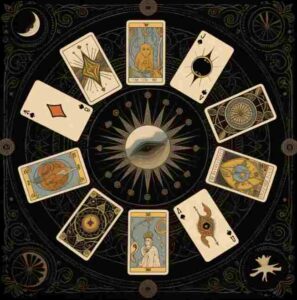When most people hear the word “tarot,” they immediately think of mystical readings, fortune-telling, and spiritual symbolism. However, long before tarot cards became associated with divination, they were used for something much more playful—games. Yes, tarot card games are real, historical games played with tarot decks, and they continue to be enjoyed across parts of Europe today.
So what exactly are tarot card games, how are they different from fortune-telling, and how can you learn to play them? Let’s explore the fascinating world of tarot as a classic card game.

Table of Contents
ToggleA Brief History of Tarot Card Games
Tarot cards originated in 15th-century Europe, likely in Italy, where they were initially created as playing cards for the upper class. These early decks were known as carte da trionfi (cards of triumph) and included a series of special trump cards in addition to the four standard suits.
The most common form of these playing cards evolved into what we now recognize as the tarot deck. The trumps were used in trick-taking games—similar to modern games like Spades or Hearts—long before people began using tarot for mystical purposes.
In many European countries, particularly France, Italy, Austria, and Switzerland, tarot card games are still played today, often under names like “Tarock,” “Tarocchi,” or “Jeu de Tarot.”
What’s in a Tarot Deck?
To play traditional tarot card games, you need a deck that typically consists of:
Four suits (usually Swords, Cups, Coins, and Batons or their modern equivalents like Hearts, Diamonds, Clubs, and Spades)
- Court cards(King, Queen, Knight, Page)
- Numbered cards(usually from 1 to 10)
- 22 trump cards, including a special unnumbered card called the Fool
This structure makes the tarot deck a bit larger than a standard 52-card deck, with most tarot game decks containing 78 cards. In gameplay, the trump cards have the power to override suit cards, similar to how jokers or high cards function in other trick-taking games.
How to Play Basic Tarot Card Games
Though there are many regional variations of tarot card games, the general concept involves trick-taking—players compete to win rounds by playing the highest card in the suit or trumping it with a higher card.
Here’s a simplified overview of how a typical game works:
- Setup: Each player is dealt a hand of cards. The number of players can vary (often 3 to 5).
- Bidding or Declaration: In many versions, players bid or announce how many tricks they intend to win or declare whether they will play solo or with a partner.
- Trick-Playing: One player leads with a card, and others must follow suit if possible. If they cannot, they may play a trump card. The highest card wins the trick.
- Scoring: Players or teams earn points based on the value of cards captured during tricks. Trump cards, especially the Fool and highest trumps, often carry special point values.
Each variation—like French Tarot (Jeu de Tarot), Austrian Tarock, or Italian Tarocchi—has its own rules, scoring system, and cultural quirks. Some are fast-paced and strategic, while others are more relaxed and social.
Where to Learn and Play
Thanks to the internet, it’s now easier than ever to explore tarot card games. You can find English translations of rulebooks, online tutorials, and even digital apps that simulate gameplay. Some communities, especially in Europe, still hold regular tarot game nights or tournaments.
If you want to get started, look for a game-specific tarot deck such as the “Tarot Nouveau” (used in French Tarot) or “Königrufen” decks used in Austria. While Rider-Waite-style tarot decks can be used in a pinch, they’re usually designed more for reading than for gameplay.
Tarot for Fun, Not Just Fortune
While tarot card reading has its place in spiritual and psychological exploration, tarot card games remind us that these fascinating decks also have deep roots in entertainment. They offer a unique blend of strategy, luck, and social interaction, and they’re a great way to connect with friends and history at the same time.
Whether you’re a card game enthusiast or simply curious about tarot’s playful origins, exploring tarot card games can add a whole new dimension to your appreciation of the deck.
0




